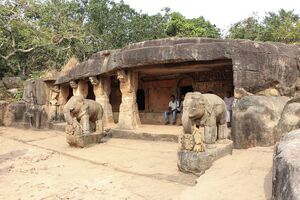Ganeshagumpha
| Author:Laxman Burdak, IFS (R) |

Ganeshagumpha (गणेशगुंफा) is a cave of archaeological, historical and religious importance near the city of Bhubaneswar in Odisha, India. It is one of the group of caves in Udayagiri. Other important caves are Hathigumpha and Ranigumpha.
Variants
- Ganeshagumpha गणेशगुंफा, उड़ीसा, (AS, p.786)
- Ganesha gumpha गणेशगुंफा
- Ganeshagupha (गणेशगुफा)
- Ganesagumpha गणेशगुंफा
History
The Ganeshagumpha is one of the best known of the 2000 year-old sandstone Jain caves of Udayagiri in Orissa. It consists of two cells with four doorways opening on to a verandah with stone benches. There is a small window- opening in the wall between the two cells. The left cell has a later representation of a Jain Tirthankara. In the right cell is the figure of Ganesha, the elephant-headed god, who lends this cave its popular name. Five pillars delineated the verandah. Three remain. They have square sections at the base and at the top, octagonal sections in the middle, and bracket capitals. A long frieze depicting groups of musicians, scenes from the royal court, and hunting scenes with people astride elephants decorates the verandah wall over the cells' entrances.[1]
Ganesha Gumpha is one of the most important caves in Udayagiri. The cave got this name due to carved figure of Ganesha on the back of its right cell. Of course, it would have been carved in the later period and it cannot be the original work. The cave has two big statues of elephants carrying garlands at the entrance and is the first example of sculpture animals used as guard to the entrance. Also, the carved figures of dwara palas are found at the entrances. The carvings in this cave narrate the story of the elopement of Bassavadatta, Princess of Ujjayini, with King Udayana of Kausambi in the company of Vasantaka.[2]
In Udayagiri, Hathigumpha (cave 14) and Ganeshagumpha (cave 10) are especially well known due to art treasures of their sculptures and reliefs as well as due to their historical importance. Rani ka Naur (Ranigumpha: Queen's Palace cave, cave 1) is also an extensively carved cave and elaborately embellished with sculptural friezes.
रानीगुंफा, उड़ीसा
रानीगुंफा (AS, p.786): उड़ीसा में भुवनेश्वर से चार-पांच मील की दूरी पर रानीगुफा स्थित है. यह जैन गुहा मंदिरों के लिए प्रसिद्ध है. इस गुंफा या गुफा का निर्माण तीसरी सदी ईसा पूर्व में हुआ जान पड़ता है. इस गुफा में जैन तीर्थंकर पार्श्वनाथ के जीवन से संबंधित कई दृश्य मूर्तिकारी के रूप में अंकित हैं. गणेशगुफा और हाथीगुफा रानीगुफा के गुहासमूह के ही अंतर्गत हैं.[3]
खारवेल के निर्माण-कार्य
खारवेल एक महान निर्माता था। उसने राजा होते ही अपनी राजधानी को प्राचीरों तथा तोरणों से अलंकृत करवाया।अपने राज्याभिषेक के 13वें वर्ष उसने भुवनेश्वर के पास उदयगिरि तथा खंडगिरि की पहाङियों को कटवा कर जैन भिक्षुओं के आवास के लिये गुहा-विहार बनवाये थे। उदयगिरि में 19 तथा खंडगिरि में 16 गुहा विहारों का निर्माण हुआ था। उदयगिरि में रानीगुंफा तथा खंडगिरि में अनंतगुफा की गुफाओं में उत्कीर्ण रिलीफ चित्रकला की दृष्टि से उच्चकोटि के हैं। इन चित्रों में तत्कालीन समाज के जनजीवन की मनोरम झांकी सुरक्षित है। उसके द्वारा बनवाया गया महाविजय प्रसाद भी एक अत्यंत भव्य भवन था।[4]
भौमकर वंश का कलिंग पर शासन
कलिंग (उड़ीसा) पर माठर वंश के बाद 500 ई० में नल वंश का शासन आरम्भ हो गया। नल वंश के बाद विग्रह एवं मुदगल वंश, शैलोद्भव वंश और भौमकर वंश ने कलिंग पर राज्य किया। पूर्व में भौमकर शासकों ने उत्तर तोसली पर शासन किया और वे शैलोद्भव शासकों के समकालीन थे जो उत्तरी कोंगोद के शासक थे । राजा शिवकर प्रथम (756 या 786 ई.) के समय तक उड़ीसा के अधिकांश तटीय प्रदेशों पर उनका कब्जा हो गया था। श्वेताक गंग राजा जयवर्मदेव के गंजम शिलालेख के अनुसार शिवाकर प्रथम ने कोंगोद और कलिंग के उत्तरी भागों पर विजय प्राप्त की।
भौमकर वंश के सम्राट शिवाकरदेव द्वितीय की रानी मोहिनी देवी ने भुवनेश्वर में मोहिनी मन्दिर का निर्माण करवाया। वहीं शिवाकर देव द्वितीय के भाई शान्तिकर प्रथम के शासन काल में उदयगिरी-खण्डगिरी पहाड़ियों पर स्थित गणेश गुफा (उदयगिरि) को पुनः निर्मित कराया गया तथा साथ ही धौलिगिरि पहाड़ियों पर अर्द्यकवर्ती मठ (बौद्ध मठ) को निर्मित करवाया। यही नहीं, राजा शान्तिकर प्रथम की रानी हीरा महादेवी द्वारा 8वीं ई० हीरापुर नामक स्थान पर चौसठ योगनियों का मन्दिर निर्मित करवाया गया।
उसके वंशज शिवकर तृतीय के तलचर शिलालेख से पता लगता है कि उसने राढ़ शासक को पराजित किया और पराजित राजा की पुत्री से शादी की थी।
External links
See also
References
- ↑ Verandah of the Ganesha Gumpha
- ↑ Allen, Margaret Prosser (1991), Ornament in Indian Architecture, University of Delaware Press, ISBN 9780874133998, p.65
- ↑ Aitihasik Sthanavali by Vijayendra Kumar Mathur, p.786
- ↑ https://www.indiaolddays.com/khaaravel-ke-nirmaan-kaary/

